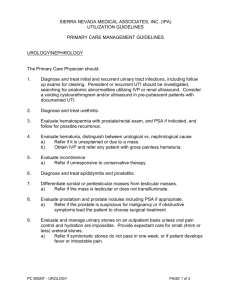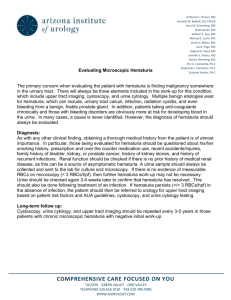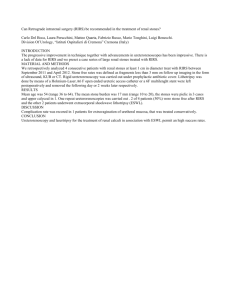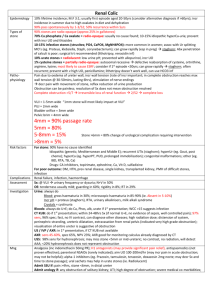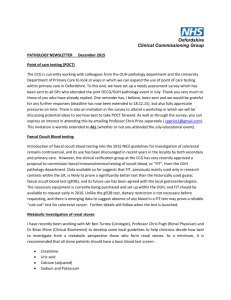Urologic Stone Disease
advertisement
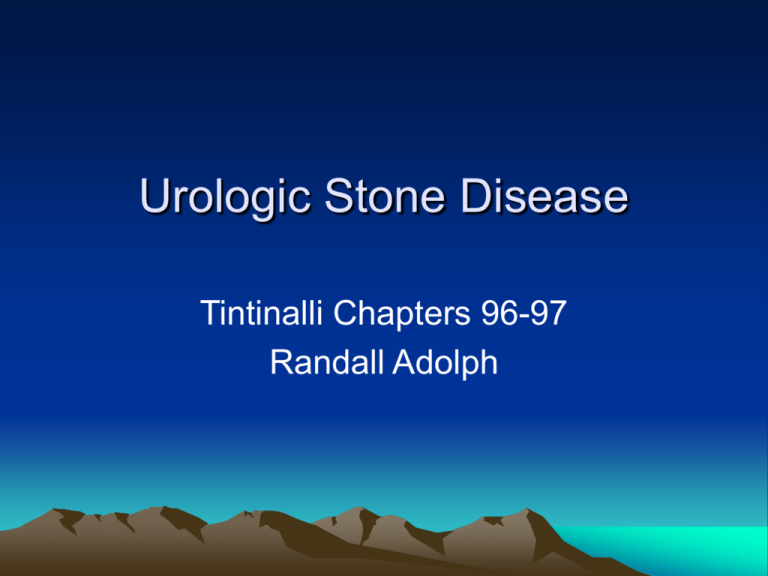
Urologic Stone Disease Tintinalli Chapters 96-97 Randall Adolph Epidemiology • 3:1 M:F (~7% men/ 3% women) • 3rd-5th decade most common (70%) • Hereditary predisposition (RTA type 1, Hyperparathyroidism, cysteinuria, milk-alkali syndrome, sarcoidosis, Crohn's disease) • Climate (mountainous, desert, or tropical) • Time of year (warmest three months) • Lifestyle (sedentary) • Medications: protease inhibitors, carbonic anhydrase inhibitors, laxatives, triamterene Patient Characteristics • <16 year old comprise 7% of cases • 1:1 M:F • Causes: metabolic abnormalities 50%, urological abnormalities 20%, infection 15%, immobilization 5% • 1/3 have recurrence within 1 year • 50% within 5 years Pathophysiology • Formation requires three key elements 1. Supersaturation of urine with solutes 2. Relative lack of the inhibitors citrate & pyrophosphate 3. Stasis or lack of urine flow • Composition: 1. 75% calcium oxalate 2. 10% staghorn calculi (struvite): associated with urease-splitting bacteria, poor Ab. penetration and usually require surgery 3. Uric acid stones 10% Composition Continued • Calcium oxolate Hyperoxaluria occurs in the presence of small bowel disease-Crohn's disease, ulcerative colitis, and radiation enteritis. • Uric Acid10% of all stones – excessive excretion of uric acid in the urine – increases with uricosuric agents – Radiolucent!!! Obstruction leads to: • Rapid redistribution of renal blood flow, ↓ glomerular filtration rate renal excretion shifts to unaffected kidney • Causes rapid decrease in ureteral peristaltic activity • Complete obstruction may lead to loss of renal function • Increased occurrence of irreversible damage after 1 to 2 weeks of obstruction • Partial obstruction lower likelihood of renal injury, may still result in irreversible damage. Critical size • 5 mm~ 90% < 5 mm and located in the lower ureter pass spontaneously • 15% pass if between 5 and 8 mm • 95% >8 mm become impacted generally requiring lithotripsy or surgical removal • 75% of stones are located in the distal third of the ureter Area of impaction • Renal calyx • UPJ, where ureter passes over pelvic brim and iliac vessels • UVJ: smallest diameter of the urinary tract • In FM the posterior pelvis: ureter is crossed anteriorly by the pelvic blood vessels and broad ligament Places for obstruction Causes of pain • Colicky, severe flank pain: hyperperistalsis of smooth muscle of the calyces, pelvis, and ureter • Dull ache: attributed to acute obstruction and renal capsular tension Clinically • • • • Usually asymptomatic until obstructs acute onset severe pain, typically at rest little if any POP Typically flank, abdomen with referral to ipsilateral labia or testicle • May be writhing in pain, reluctant to lie still • Episodic as passes, pain free until obstructs more distally Urinary pH • pH> 7.6 suspicious for urea-splitting organisms because the kidney will not, under normal conditions, produce urine in this alkaline range. • pH < 5 often associated with the formation of uric acid calculi. LABORATORY • UA hematuria supports diagnosis, absent in 15% ;crystals seen w/wo stones • Dipstick detects heme, myoglobin and porphyrins, need micro (see RBCs) • Urine C&S, • BUN & Creatinine especially if imaging with RCM, higher rates of complications in DM >1.5, CRF >2.5 Imaging • performed with a first episode of renal colic. • Other indications: – Diagnosis is unclear – Those in whom a proximal UTI, in addition to a calculus, is suspected. • A KUB is the standard, initial radiograph done before injecting contrast media during IVP. Imaging • Helical CT preferred modality • US if pregnant • Others IV urography, Radionuclide renal scan, plain abd. Film • Shows stone, location, IDs complications • Unilateral ureteral dilatation and perinephritic stranding together: PPV 96% • Both absent NPV 93-97% Noncontrast CT • Advantages: fast, avoids RCM, • Disadvantages: specificity/sensitivity low for other pathologies (AAA, appendicitis) • Does not evaluate renal function or degree of obstruction • If negative may need RCM to look for other cause of pain IV Urography • Indicators of obstructing stone: – 1st and most reliable indicator of obstruction is a delayed nephrogram in the 5-minute film – Visualization of the entire ureter is suggestive of obstruction – Ureteral contrast column cutoff, prolonged nephrogram, renal enlargement, dilatation of the collecting system, contrast extravastation Helical CT • • • • • Advantages: provides info on function Disadvantages: uses RCM (allergy,nephrotoxic) Nephrotoxicity: 9% in pts. with RI or DM BUN, Creatinine before RCM Metformin & RCM severe Lactic acidosis, nephrotoxicity • False negative if stone small, radiolucent, partially obstructing, or passes into bladder before contrast passed by kidneys US • • • • • During pregnancy, children May misses stones < 5mm Less sensitive in middle ureter Overall low sensitivity/specificity for stones 98% sensitive for hydronephrosis, however 22% of cases not associated with obstruction US • Advantages: – noninvasive, no dyes or radiation, no known side effects – Superior to IVU for UVJ stones • Disadvantages: – excretion function not evaluated operator and equipment dependant – obesity may hinder ability to perform Plain Films • 90% stones radiopaque (Ca > Struvite > Cystine) • Uric acid and stones associated with medications radiolucent • Overall poor Sensitivity & Specificity • Greatest utility is excluding other pathologies Stone gone wild • infection occasionally occurs in the presence of an obstructive stone. • A history of fever and chills strongly suggests superimposed infection and is a urologic emergency. It is imperative to do an IVP or an ultrasound study in these cases • Sterile pyuria strongly suggests renal tuberculosis; confirmation acid-fast bacilli Differential Diagnosis • Aortic dissection , AAA • Appendicitis: usually don’t see rebound, guarding, distention with stone • Infectious: fever with CVA, consider pyelonephritis • Papillary necrosis: DM, SCD, NSAID abuse; see Hematuria and pyuria • Vascular:Renal vein thrombosis, Mesenteric ischemia • Gynecological vascular etiology • If suspected, a contrast CT or angiogram done. • Relatively rare: m/c renal artery embolism, most often of cardiac origin (atrial fibrillation, subacute bacterial endocarditis, mural thrombus) • IVP should demonstrate decreased or absent excretion of contrast material. Immediate angiogram indicated early diagnosis allows possible salvage of the ischemic kidney Predisposing factors for renal vein thrombosis include the nephrotic syndrome, malignancies, and pregnancy TREATMENT • Pain control: Opiods and nsaids • NSAIDs: analgesic, decrease ureterospasm and renal capsular pressure by diminishing GFR in the obstructed kidney. • Obstruction with Infection: Urology emergency • Consult if: RI, Severe underlying disease, extravasation or complete obstruction, Multiple ED visits, large stone, sloughed renal papillae Management • Average time to pass stone varies (7-20 days) • Long acting CCB (Nifedipine) and steroids may enhance passage • F/U Urology in 7 days • Stone saved/submitted to urologist for analysis. • Dispo: return immediately if intractable, severe pain, persistent nausea and vomiting, fever and chills Indications for Admission • • • • • Obstruction with infection Persistent pain Persistent nausea and vomiting Urinary extravasation Hypercalcemic crisis Relative Indications for Admission • • • • • • High-grade obstruction Solitary kidney Intrinsic renal disease Size of obstructing stone Duration of symptoms Social situation Admit • severely dehydrated • unrelenting pain or vomiting • underlying infection with hydronephrosis Bladder stones • different from renal stones • almost exclusively elderly men • most often complication of other urologic disease (Proteus). • The other common indwelling catheter • May complain of sudden interruption of the urinary stream. This strongly suggests a vesical stone that intermittently obstructs the bladder outlet Hematuria and Hematospermia • Tintinalli Chapter 97 Hematuria • Definition: – >5 RBCs/hpf warrants an attempt at definitive diagnosis • Timing: – Initial suggests urethral disease – B/n voiding and only staining undergarments, with clear urine distal urethral or meatus – Total disease of kidneys, ureters, or bladder – Terminal bladder neck or prostatic urethra • Amount – Gross hematuria lower tract cause while microscopic tends to be kidney disease • Color: – Brown/Smokey colored with casts and proteinuria suggests glomerular – Red clotted blood indicates source below kidney HEMATURIA • a harbinger of serious urologic disease • Gross hematuria 5X more likely to have lifethreatening conditions when compared to those with microhematuria. • Lower and middle urinary tract ~60% • Urologic malignancies 2.2% to 12.5% with microscopic hematuria, up to 20% if > 50 years with gross hematuria. • Gross hematuria (>3 red blood cells/hpf on two of three urinalyses found a potentially life-threatening lesion in 9.1% of these patients. Hematuria • Young Pts. most often urolithiasis or UTI • Consider glomerulonephritis, goodpasture, HSP, Wilms Tumor, SCD/trait • PSGN 7-14 days following pharyngitis, Abs do not prevent this • IgA nephropathy following viral URI • Elderly: infection, Nephroolithiasis, bladder, prostate, renal CA Other sources of bleeding • infection of the bladder (hemorrhagic cystitis) • varices of the bladder • Diverticula • bladder stones • postradiation changes • Anticoagulation at currently recommended levels does not predispose patients to hematuria Risk factors for Uroepithelial CA • • • • • • • Age >40 Excessive analgesic use Smoking Exposure to dyes, benzenes, aromatic amines Pelvic irradiation Cyclophosphamide Hematuria in patients on blood thinners, have underlying disease 80% of the time glomerular and nonglomerular • glomerular origin: frequently associated with dysmorphic erythrocytes, RBC casts, and significant proteinuria (2+ to 3+) • IgA nephropathy (Berger's disease) m/c, cause • nonglomerular hematuria: uniformly round erythrocytes and absence of erythrocyte casts and proteinuria. glomerular disease • Typically young males have hematuria, erythematous skin rash, and fevers suggesting immunoglobulin nephropathy, or Berger's disease • Family history of deafness, renal disease, and hematuria is linked to Alport nephritis. • A rash, arthritis, and hematuria are seen with systemic lupus erythematosus. • Hematuria, hemoptysis, and microscopic anemia are common presentations of Goodpasture's syndrome. • A preceding upper respiratory infection, pharyngitis, skin infection, or rash with associated hematuria suggests poststreptococcal glomerulonephritis. nonglomerular disease • A family history of bleeding disorders or renal cystic disease suggest hemophilia and polycystic kidney disease, respectively. • Suspect papillary necrosis in diabetics, sickle cell patients, and analgesic abusers (Classic urolithiasis, sudden flank pain and hematuria) Diagnosing • • • • • Clarify symptoms and source: traumatic/atraumatic Gross/micro Initial/total/terminal Associated symptoms: flank pain, menstruation, dysuria, etc. • Travel (schistosomiasis) • Abnormal RBC morphology, casts, protein suggest glomerular source • Strenuous exercise frequently cause, but deserves investigation even if spontaneously resolves Exercise-Induced • Exercise-induced hematuria that does not resolve after 48 hours commonly results from punctate hemorrhagic lesions suggesting bladder cancer • Diagnosed by cystoscopy dipstick • positive only if there has been lysis of RBCs or with myoglobinuria. • [Hemoglobin] greater than 0.003 mg/L (10,000 red blood cells/mm3 or 1 to 2 RBCs/hpf) • Current recommendations: urinalysis and cytology for 3 consecutive years if resolution of hematuria or persistent asymptomatic microhematuria • ross hematuria should be reevaluated in all instances Renal Imaging • IVP clearly delineates most renal tumors, obstruction, or stones and their precise location – Disadvantage: RCM, does not assess aorta, retroperitenium and pelvis • Helical CT fast highly sensitive and specific for stone, RCM used for other pathologies • Renal US to screen for AAA, Hydro, obstruction. Study of choice in Pregnant and children – Disadvantages: rarely identifies small stones, no idea of functioning, Treatment • Abs. for infection • Pain meds. & hydration for nephrolithiasis • D/C only if asymptomatic, tolerating PO, Abs. & analgesics & no sig. comorbidities • <40 to PCP for repeat UA 1-2 weeks, if persists or >40 and risk for CA, Urology for cystoscope • Asymptomatic microscopic hematuria associated with a 2 fold increase of future RF • Proteinuria: a sign of prognostically significant glomerular disease & needs further workup Complications • Gross hematuria may lead to intravesical clot and subsequent outflow obstruction • New glomerulonephritis: at risk for Pulmonary edema, volume overload, azotemia or HTN emergency need admission • Pregnant: May be preeclampsia, pyelonephritis, obstructing stone call OB and possibly admit Hematospermia • Trauma, injury (tumor with erosion), inflammation, infection of ejaculatory system • M/C iatrogenic from instrumentation, radiation. • >40 prostate CA, BPH considerations • <40 prostatitis, seminal vesiculitis, urethritis, STD, epididymo-orchitis, calculi, TB • UA warranted • Usually benign, but urology referral indicated Questions? Question 1 • What season is associated with an increased incidence of stones? a) b) c) d) Winter Spring Summer Fall Answer C Question 2 • True or false: Hematuria seen in a patient on therapeutic levels of blood thinners is usually microscopic and benign? False: underlying pathology 80% of time Question 3 • In the ED what is a value fror defining hematuria? a) b) c) d) Answer: D Any RBCs/hpf 2 RBCs/hpf 4 RBCs/hpf 5 RBCs/hpf Question 4 • The most common cause of stone formation is? a) b) c) d) a) metabolic abnormalities urological abnormalities infection Immobilization Answer: A 50% Question 5 • What is the most common composition of renal stones? a) b) c) d) Uric acid stones struvite calcium oxalate Magnesium Answer: C
